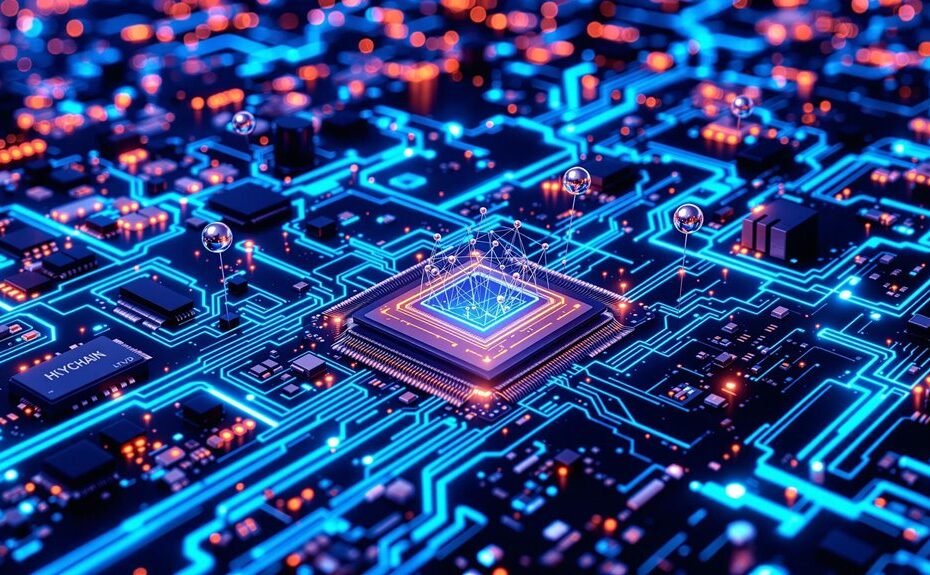When it comes to AI agent networks, you need blockchain protocols that prioritize security, scalability, and interoperability. Based on your needs, the top three blockchain protocols are Ethereum 2.0, Solana, and Polkadot. Ethereum 2.0 offers improved scalability and security, while Solana provides high transaction speeds and low fees ideal for real-time AI interactions. Polkadot, conversely, facilitates seamless interoperability across blockchains and custom parachains for AI applications. As you investigate these protocols further, you'll realize how they can unleash the full potential of AI agent networks in various industries.
Need-to-Knows
- Ethereum 2.0 offers improved scalability and security, with $350M+ Total Value Locked (TVL) in AI projects, making it a top choice.
- Solana's high transaction speeds and low fees make it ideal for real-time AI interactions, supporting fast and efficient AI agent networks.
- Polkadot's interoperability across blockchains and custom parachains enables seamless communication and coordination between AI applications.
- Binance Smart Chain's cost-effective and fast transactions make it suitable for AI applications, providing an affordable and efficient solution.
- Cosmos SDK's modularity and customizability allow for tailored AI-centric blockchain solutions, offering flexibility and adaptability for AI agent networks.
Secure Agent Communication Protocols
When building AI agent networks, secure communication protocols are frequently the unsung heroes that safeguard the integrity and confidentiality of data exchanged between agents. You need to guarantee that your AI agents can communicate securely, especially in decentralized environments where privacy is paramount.
Protocols like ZeroChain utilize zero-knowledge proofs to improve security, allowing AI agents to verify transactions without revealing sensitive information. Phala Network's multi-proof AI execution layer supports secure off-chain computations, allowing AI agents to operate with privacy while maintaining transparency through its Polkadot parachain architecture.
You can additionally utilize encryption methods like SGX in the Secret Network to facilitate confidential computing, safeguarding user data from unauthorized access during interactions. By implementing effective secure communication protocols, you can contribute to the overall trustworthiness of your AI agent networks, promoting user confidence and encouraging broader adoption in industries like finance and healthcare.
With secure communication, you can guarantee that your AI agents exchange data with confidence, knowing that blockchain technology has got their backs.
Best Blockchain Protocols for AI
Five leading blockchain protocols stand out for their exceptional support of AI agent networks, each offering unique strengths that cater to specific needs and use cases. When it comes to deploying AI-centric decentralized applications (dApps), you'll want to contemplate the following protocols.
| Protocol | Key Strengths |
|---|---|
| Ethereum 2.0 | Improved scalability, security, and $350M+ TVL in AI projects |
| Solana | High transaction speeds, low fees, and support for real-time AI interactions |
| Polkadot | Interoperability across blockchains, custom parachains for AI applications |
| Binance Smart Chain | Cost-effective, fast transactions, and low fees for AI applications |
| Cosmos SDK | Modularity, flexibility, and customizability for AI-centric blockchains |
Each protocol offers distinct advantages that can uplift your AI agent network. Ethereum 2.0 provides a robust foundation for dApps, while Solana excels in real-time interactions. Polkadot's interoperability allows seamless communication across platforms, and Binance Smart Chain offers a cost-effective environment. Cosmos SDK, meanwhile, permits custom blockchain creation tailored to specific AI needs. By understanding the strengths of each protocol, you can reach educated conclusions about which one best fits your AI agent network requirements.
Top AI Agent Network Solutions

You're likely seeking AI agent network solutions that can effectively utilize blockchain protocols to access their full potential. Search no more, as top solutions have emerged to revolutionize the space.
Morpheus AI on Ethereum stands out, with a Total Value Locked (TVL) exceeding $350M, showcasing the significance of AI agents on public chains.
Virtuals Protocol, built on Base Layer2, is rapidly growing in user adoption, demonstrating the increasing demand for tokenized AI agents.
Phala Network, a Polkadot Parachain, focuses on privacy-preserving appchain solutions, enabling secure execution of AI models and contracts.
For automating trading and financial management, AIXBT by Virtuals specializes in crypto trading strategies, illustrating the application of AI agents in blockchain networks.
Zeeve RaaS provides a streamlined process for launching custom chains tailored for AI agents, enhancing performance and interoperability within decentralized applications.
These solutions bridge the gap between AI agents and blockchain networks, enabling market predictions and more.
Most-Asked Questions FAQ
Which Blockchain Protocol Is Best?
When choosing a blockchain protocol, you're considering Ethereum's scalability, Solana's transaction speeds, and Polkadot's interoperability solutions. You'll weigh the trade-offs between smart contracts, consensus mechanisms, and decentralized applications, prioritizing token standards, privacy features, network security, and governance models that fit your project's needs.
How to Combine AI and Blockchain?
You combine AI and blockchain by implementing AI governance models, leveraging blockchain security measures, and enabling decentralized data sharing, then utilizing smart contract applications for AI model training, and incentivizing with tokenized rewards, while ensuring interoperability and privacy through distributed ledger advantages and autonomous decision making.
What Are the Three Main Blockchain Protocols?
You're looking for the top three blockchain protocols, and I've got you covered! Ethereum offers advantages in smart contracts, Solana boasts lightning-fast speeds, and Polkadot facilitates seamless interoperability between blockchains – a trifecta of power and flexibility.
What Blockchain Does Fetch Ai Use?
You're probably wondering what blockchain Fetch AI uses – it's its own Layer 1 blockchain, designed specifically for decentralized AI agent networks, ensuring scalability, security, and interoperability through its unique architecture and features.
Conclusion
You've made it to the end of this journey into the world of blockchain protocols for AI agent networks. Now, it's time to put your newfound knowledge into action. With the top three blockchain protocols – Polkadot, Cosmos, and Corda – you're equipped to build secure, scalable, and decentralized AI agent networks. Remember, the future of AI depends on the ability of agents to communicate seamlessly and securely, and you hold the key to revealing that future.
